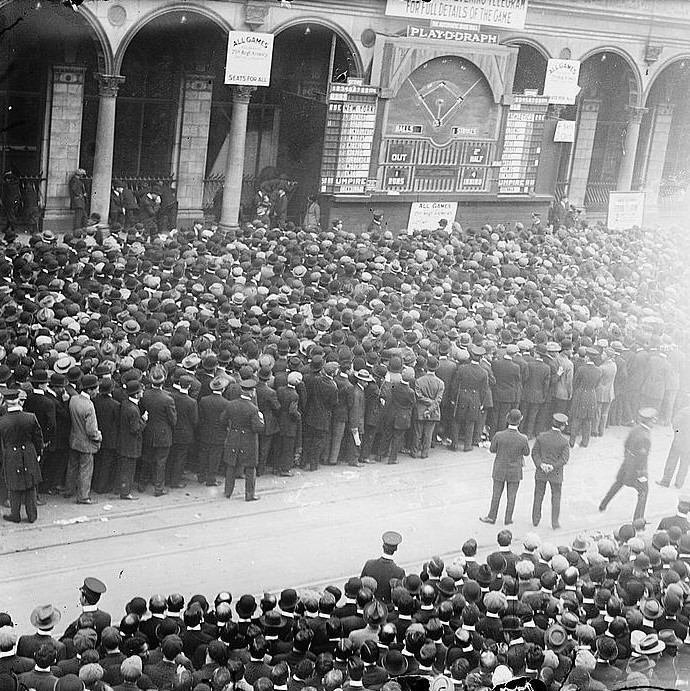Changing media, Changing The Lamp
This image from the Library of Congress Bain Collection shows people crowded outside the New York Herald newspaper’s building to watch the Playograph update action in the 1911 World Series between the New York Giants and Philadelphia Athletics.
May 4, 2022
Imagine being excited about the World Series, but your only option to witness the game live was to gather in the street, wearing suit coat and hat, and stare at a mechanical scoreboard.
Before television and radio, towns across the United States would put a Playograph machine on the front of the newspaper office. People would gather to watch the sign.
A telegraph would deliver the play by play, and an electronic signal would update the sign with the latest pitches, strikes, hits and runs. It seems like such an odd way to watch a baseball game – until you catch yourself checking the latest scores and happenings on MLB.com’s GameDay, which is just a digital Playograph.
Eventually, radio and television took the place of the Playograph. Today, phones are taking the place of television as the medium to watch or follow a game.
Years ago, the printed page was the only way to get news. Then, radio and television tried to upset the paper-based medium. But it never succeeded. Perhaps it’s because, as longtime television Broadcaster Walter Cronkite used to say, broadcast news is at best a “headline service.” Broadcast can’t provide the same depth that a print medium could. But the Internet came along, and the restrictions of airtime and printed page size vanished. The printed page lost what might have been its final advantage to other media.
If you put a Playograph on the front of a building, people would watch only for as long as the pangs of nostalgia persisted. The printed page is much the same way. People pick up fewer papers. They have other ways of getting the score from last night’s game or the latest news. Those ways are equally reliable, faster, and have video and pictures. The need for print just isn’t there.
That is why The Lamp has cut back on printing papers. Students don’t pick them up to have something to look at during the five minutes before class starts.
The Lamp has emphasized providing content on its website, thelamponline.com, since it was introduced in 2014 and has used social media to bring readers to the website. We stopped printing a paper during the pandemic, as there were no students or employees on campus to pick it up. It wasn’t hard to make that change: We were already doing everything online. When we returned in fall 2021, we did a couple papers but quickly realized it took a lot of training in a skill that doesn’t have a strong value for aspiring journalists. And it took time and money to create.
While it’s sad to think that this might be our last printed news product at Lincoln Land, we also know the work of journalism can continue in a different medium. We offer this magazine as a look at the end of the print era and The Lamp as a predominantly print publication. We wanted to mark the ending of this chapter.
The Lamp staff hopes that a once-a-semester or once-a-year magazine might be sustainable. But that’s up to future Lamp staffs to decide. Plus, it won’t be the focus; it will be something to showcase the best work at the end of the term.
Instead, the focus will be on the daily or weekly updates to the website. It will be podcasts and videos. It will be more of what we already do, without having to stop that work to create a print edition.
We hope you’ll take a moment to think about the history of The Lamp. And we hope you’ll take a moment to think about the future of The Lamp and journalism in this post-print world. And please, find us on social media and like, follow or subscribe. The Lamp hopes to keep shining for at least 54 more years as a digital publication, until the next big change comes along that makes this approach seem as strange as that picture of the Playograph.
